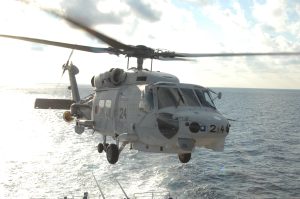Two Japan Maritime Self-Defense Force (MSDF) helicopters crashed late on April 20 during nighttime training near the Izu Islands, leaving one crew member dead and seven others missing.
Japan’s Defense Minister Kihara Minoru said in a nationally televised news conference on the following day that two Mitsubishi-built SH-60K anti-submarine warfare helicopters, each with a crew of four, lost communications at around 10:38 p.m. and 11:04 p.m. local time on April 20, respectively, above waters about 150 nautical miles (277.8 kilometers) east of Torishima Island, part of the Izu island chain south of Tokyo in the Pacific Ocean.
Kihara said that the cause of the crash was being still investigated after the two SH-60K helicopters’ flight recorders were found close together, adding that “there is a high possibility of a collision in mid-air.”
Kihara also said on April 22 that no data have been found so far indicating the aircraft had any abnormalities, suggesting the crash was caused by human error, not a technical glitch.
As the waters around the crash site are about 5,500 meters deep, search operations for the seven missing crew members are extremely difficult. The MSDF plans to send an auxiliary oceanographic research ship to conduct a sonar search.
NHK, Japan’s national public broadcaster, on April 22 reported the two JMSDF helicopters had not been linked to each other on a location information sharing system at the time of the accident.
In recent years, the Self-Defense Forces have had a number of accidents during training. In January 2022, an Air Self-Defense Force (ASDF) F-15 fighter jet crashed off the coast of Ishikawa Prefecture. Both pilots are said to have suffered from spatial disorientation, a loss of balance.
In April 2019, an ASDF F-35 fighter jet crashed off the coast of Aomori Prefecture due to what appeared to be spatial disorientation. In August 2017, an MSDF SH-60J patrol helicopter, the predecessor to SH-60K involved in the latest accident, crashed off the coast of Aomori Prefecture, killing two people and leaving one missing.
There was also an accident in July 2021 when one SH-60K and one SH-60J collided during anti-submarine warfare training off the coast of Amami Oshima, Kagoshima Prefecture. The MSDF concluded that the collision occurred because the crews’ “understanding of each other’s movements was insufficient.” Just like this time, the July 2021 accident also occurred during a night training.
In relation to this accident, a veteran member of the MSDF, who has experience as a naval captain, told The Diplomat on April 22 that the service has been very busy responding to a series of missile launches by North Korea as well as stepping up warning and surveillance activities around the Senkaku Islands (claimed by China as the Diaoyu Islands) in Okinawa Prefecture, where Chinese government vessels have repeatedly invaded territorial waters, among other activities.
The MSDF official pointed out the increasing number of duties, missions, and activities have been squeezing training opportunities and training periods for service members, thus inevitably causing a series of accidents.
“The fact that the increasing number of missions is putting pressure on training opportunities and training periods has been a problem for many years at the MSDF,” the officer said.
As China strengthens its maritime expansion around the Japanese archipelago, the JMSDF has recently increased its joint training exercises at sea with the Japan Coast Guard and other countries, in addition to independent drills.
According to the 2022 Defense White Paper, the SDF participated in 19 multilateral joint exercises in fiscal year 2013; the number of such exercises had more than doubled to 43 in fiscal year 2022.
In particular, the number of major joint training exercises between the SDF and the U.S. military is rapidly increasing. In 2022, the number reached 108, compared to just 24 in 2013. This means the number of Japan-U.S. joint exercises has increased by 4.5 times over the past 10 years.
Did this hectic field environment have a negative impact on the nighttime anti-submarine warfare training, which requires advanced techniques?
The officer also pointed out the strain on the service members is being felt on the MSDF’s front lines.
In particular, the MSDF is suffering from a serious manpower shortage. The actual number of the service’s personnel was 43,106 as of the end of March 2023, versus its authorized strength of 45,293, for a staffing rate of 95.2 percent.
In contrast, 10 years ago, as of the end of March 2013, the actual number of the service’s personnel was 42,007, and the staffing rate was 92.3 percent for the authorized strength of 45,517. Although the staffing rate increased over the past 10 years, the authorized strength actually decreased by 224 personnel.

































